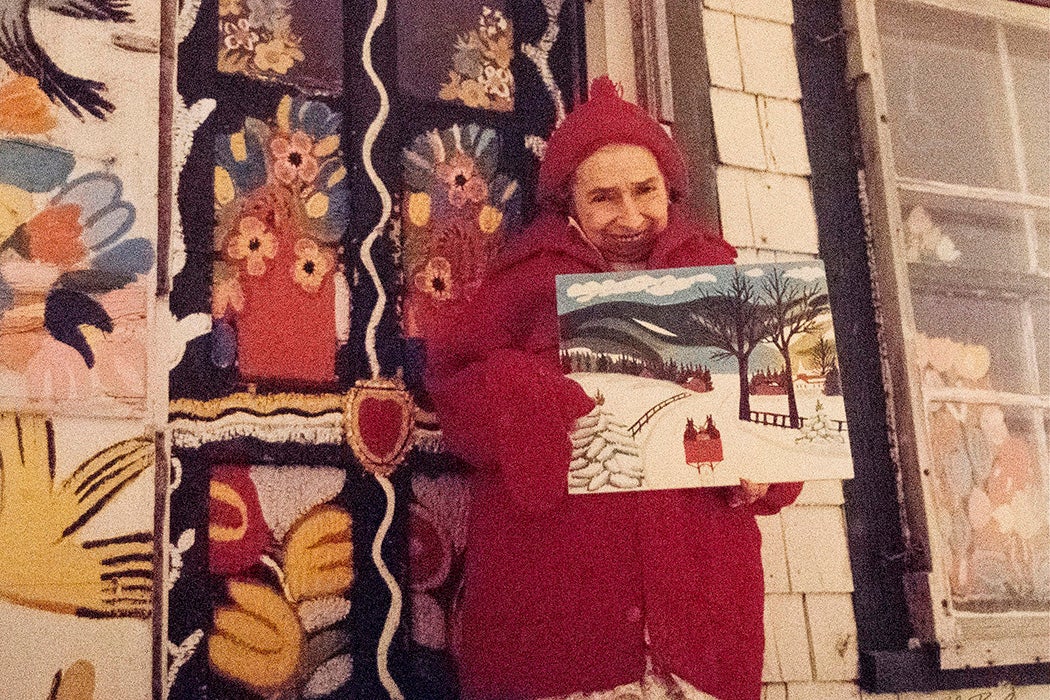“Live-in or keep house.” Fish peddler Everett Lewis slapped this short ad on the walls of shops all over Marshalltown, Nova Scotia, in January 1938. Maud Dowley accepted the job. She also convinced the crabby Everett to marry her, and she became Mrs. Maud Lewis only weeks later. She did keep house and cook for her husband for a short while, but it was on the walls, countertops, and furniture of the Lewis house that her real work took place.
Maud Lewis (1903–1970) was, and still is, one of Canada’s most celebrated folk artists, but even so, she’s often left out of the conversations about Canadian women’s art history. Lacking the training and sophistication of the Montreal-based Beaver Hall Group and the radical intrepidness of Vancouver artist Emily Carr, Lewis took a humble approach to creating and circulating her art. There was no scheming to get her paintings exhibited in the most prestigious salons or museums and no courting influential patrons for grand commissions or pensions. She didn’t associate with the Group of Seven—whose legacy commanded the Canadian art world at the time—and she didn’t study or teach at a famous art school. Rather, she sold her hand-painted Christmas cards door-to-door, decorated every inch of the house she shared with her husband with whatever she felt like painting, and charged very modest prices whenever tourists stopped by her home to view her work or purchase one of her pieces. Maud Lewis was all talent and no ambition. Not necessarily the stuff of a standard feminist icon.
But perhaps that was Lewis’s secret to such uninhibited artistic expression. She was out to impress no one but herself, and her body of work was socially as well as personally defiant. She suffered from rheumatoid arthritis for the majority of her life, and it took almost superhuman willpower to paint as productively as she did through the pain. Lewis’s subjects were simple. According to art historian Erin Morton, Lewis took the natural world and made it colorful and cheerful to combat the gloom and boredom of everyday life.
“Lewis seemed to triumph over such obstacles as disability, gendered economic marginalization, and rurality,” Morton writes,
through the joyful optimism of her small painted panel board landscapes, which infused everyday scenes of Digby County life with bright colours painted in a raw, gestural way. Moreover, because Lewis’s paintings portrayed such rural activities as oxen pulling, fishing, and logging, they came to serve as a novel example of the resilience of traditional living for those public history makers seeking to grapple with the province’s increased modernization during the 1960s and 1970s.
Preserving Lewis’s house and its paintings for future generations is a responsibility that the Nova Scotia art community and local authorities take seriously, writes Morton in her analysis of the commemoration of Lewis’s life. The house still stands, long after Lewis and her husband succumbed to illness and old age.
Though the Art Gallery of Nova Scotia began to promote Lewis as “Canada’s best-loved folk artist” in the 1990s, a biopic about her wasn’t released until 2016. Directed by Aisling Walsh, Maudie dramatizes Lewis’s quiet art career and long—and often troubled—marriage with her temperamental husband. The film stars Sally Hawkins of The Shape of Water as Maudie and Ethan Hawke as Everett. The film succeeded in drawing Lewis back into the spotlight in a period when Canada, distracted as it was by events in other countries, was in danger of forgetting her altogether and losing awareness of its own cultural heritage. Maud Lewis stands today as a symbol of true Canadian resilience, resourcefulness, and pride.
Support JSTOR Daily! Join our membership program on Patreon today.







